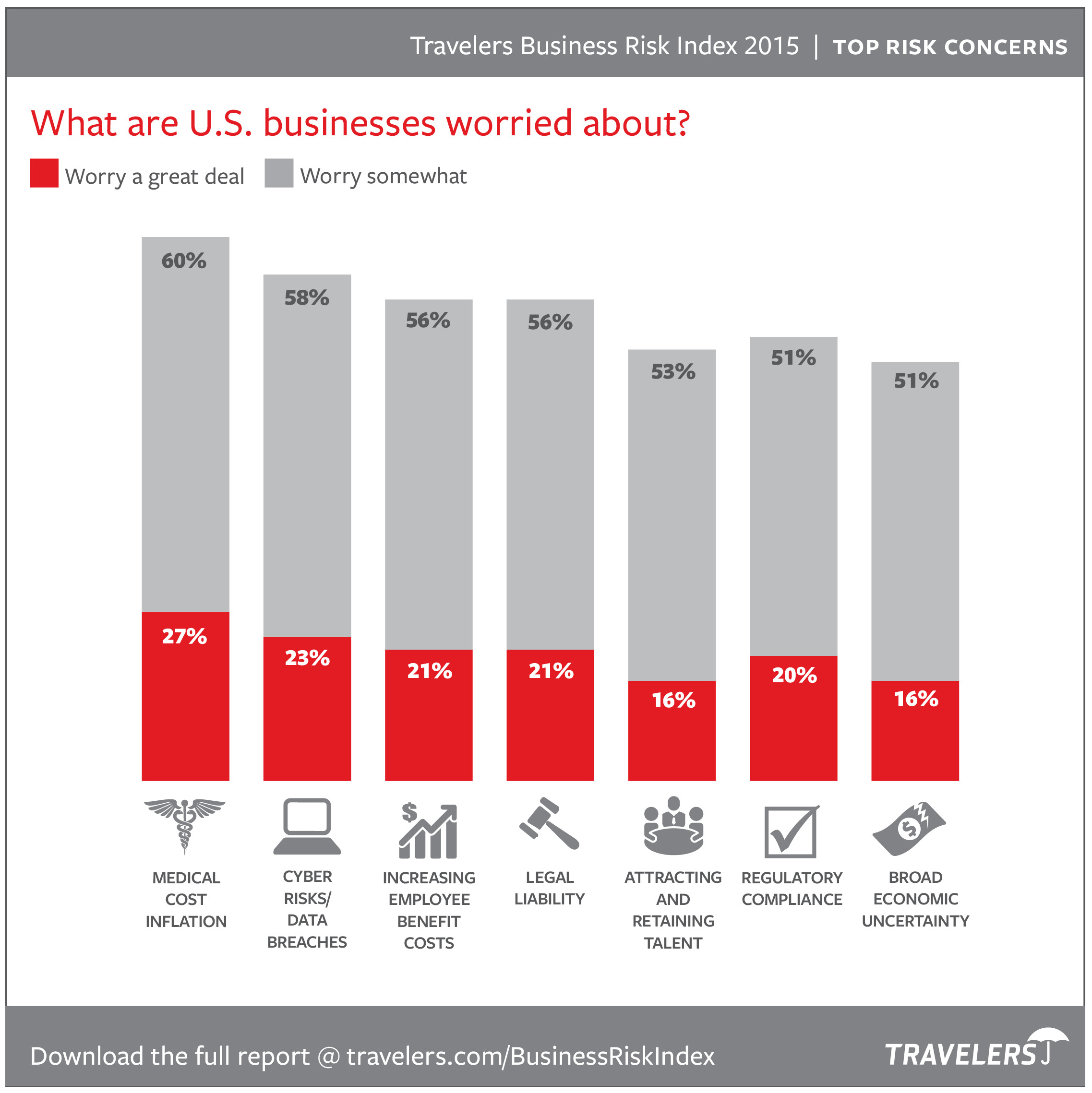Do you remember that old Avis commercial about which company wasthe No. 1 car rental company? Avis used the slogan, “We’re No. 2,but we try harder.” You might say that about cyber risk andhackers, too: Cyber risk is the second biggest concern for U.S.businesses, according to the second annual Travelers Business Risk Index. But hackers are trying harder tobreach data security and obtain private information, which couldsee the risk rise to No. 1 soon.
|“The top three concerns are indicative of the ever-evolvingrisks that pose threats to American businesses,” says MichaelKlein, executive vice president and co-president of BusinessInsurance at Travelers. “Yet, when it comes to managing risk,businesses are often least prepared for their most worrisomeconcerns. Fortunately, many of these risks can be mitigated andresources are available to help businesses of any size stayprotected.”
|Business leaders seem to be more optimistic than they were lastyear, however. Fewer survey respondents reported concerns about theeconomy and fewer believe the world is becoming riskier.
|Cyber risks
|Up from fifth place last year, cyber risks ranked as the secondbiggest concern for all businesses. Malicious and criminal attacksconcern businesses the most (55%), along with human error (24%) andsystem glitches (21%).
|The types of malicious attacks most worrisome to businessesinclude the following:
- Having computers or data systems infected with a virus(57%)
- Someone gaining access to their banking accounts or financialcontrol systems (51%)
- A security breach or someone hacking into their computersystems (50%)
Among leaders of large businesses, 70% rank cyber risks as theirbiggest concern.
|Click through to see what other risks made the Top 5 this year,including the biggest one on executives' minds.
|
Source: Travelers
|Medical cost inflation tops the list
|Medical cost inflation worried more survey respondents (60%)than any of the other risks in the 2015 Travelers Business RiskIndex. Although many business decision makers indicated concernwith this issue, it was not as important a concern as last year(60% versus 67% in 2014). Slightly more than one-third (33%) ofrespondents said that medical cost inflation is among the risksthey are least prepared to manage.
|Here is the way the respondents ranked other risks:
|Legal liability. Legal liability-related riskscontinue to be another significant source of concern for 56% ofbusiness decision makers, the survey found. Specific concernsinclude the following:
- Professional mistakes, errors and omissions (42%)
- Employee lawsuits for discrimination, harassment and wrongfultermination (34%)
- Customer slips and falls and driving accidents caused byemployees (33%)
Global political conflict. Among businessleaders, one of the most significant increases in concerns isrelated to global conflict. It’s a concern for 32% of surveyrespondents, up 8% from 2014. Political unrest is a larger concerntoday than it was five to 10 years ago for one-quarter of thedecision-makers surveyed, which is an increase of 4% from 2014.
|Weather. Severe weather has become morefrequent said 52% of the respondents, but only 38% believe that isthe case for their geographic area, and only 32% believe that ithas increased the likelihood of damage to their business. TheNortheast stood out as a notable exception: 51% believe that severeweather is more frequent in their area. Surprisingly, only 41% ofsurvey respondents have a business disaster recovery plan in placeto help them get back to normal after a disaster.
|Risk management. Risk management wasnot a strategic priority for most survey respondents,especially among decision-makers at small businesses. Of thatgroup, only 11% named risk management as a strategic priority or animportant management activity, compared with 20% of medium-sizedbusinesses and 36% of large companies.
|About the survey
|Hart Researchconducted a national online survey of 1,210 businessdecision-makers from Feb. 18, 2015, to March 4, 2015. Smallbusinesses are defined as those having 2–49 employees, mid-sizedbusinesses as having 50–999 employees, and large business as having1,000 employees or more. For full results, including industryspecific information, click here.
Want to continue reading?
Become a Free PropertyCasualty360 Digital Reader
Your access to unlimited PropertyCasualty360 content isn’t changing.
Once you are an ALM digital member, you’ll receive:
- All PropertyCasualty360.com news coverage, best practices, and in-depth analysis.
- Educational webcasts, resources from industry leaders, and informative newsletters.
- Other award-winning websites including BenefitsPRO.com and ThinkAdvisor.com.
Already have an account? Sign In
© 2024 ALM Global, LLC, All Rights Reserved. Request academic re-use from www.copyright.com. All other uses, submit a request to [email protected]. For more information visit Asset & Logo Licensing.








